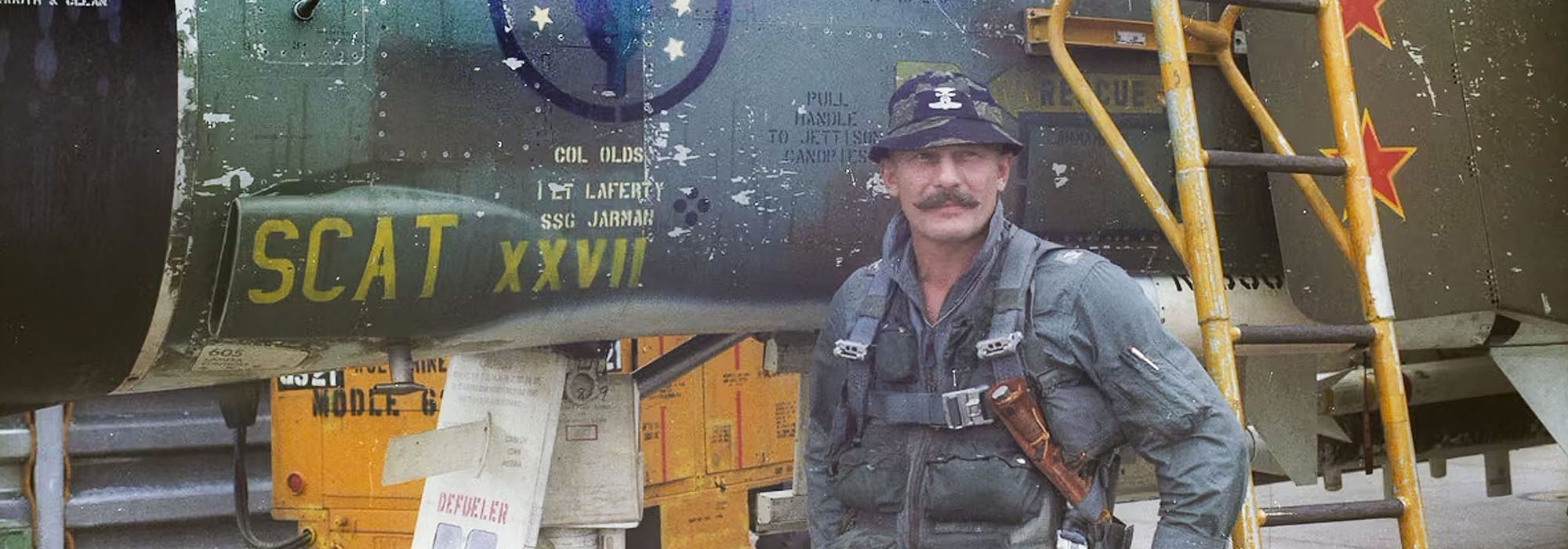Larger-than-life legend on the battlefield and the football field.
Olds was a legend in the Air Force. He had been an All-American football player at West Point (tackle), was an ace in World War II with 13 victories, and married the glamorous movie actress Ella Raines. He was the quintessential fighter pilot. As he put it: “Bombers drop bombs. Fighter pilots fight. It was simply the way it was meant to be.”
Robin’s father was Air Corps pioneer Robert Olds, a charismatic and dedicated Airman as well as highly capable commander. During World War II he led Ferry Command and was in line to take over a bomber unit in England but died of heart problems in April 1943, thus cutting short a very promising career.
Robin was then a cadet, where he did all right academically and militarily, but it was athletic prowess that won him collegiate fame. He was big, muscular, and rugged. He graduated a year early due to the war, won his wings, and went to Europe where he flew P-38s and P-51s, soon becoming an ace—in both aircraft.
He spent the Korean War stateside, made colonel in 1953, and continued to fly fighters. In September 1966 he went to Southeast Asia and took command of the 8th Tactical Fighter Wing at Ubon Air Base in Thailand. His vice wing commander and good friend was Daniel “Chappie” James, who would become the first Black four-star general in U.S. history. As a team, they were known as “Blackman and Robin.”
When bomb-laden F-105s went north they were usually escorted by F-4s and Wild Weasels—two-seat F-105Fs that would jam and attack enemy radars. If MiGs showed up, the Thuds would continue to the target while the Phantoms engaged the MiGs. The North Vietnamese were aware of these tactics, so they avoided the Phantoms when possible.
Olds’ plan, Operation Bolo, proposed that F-4s mimic an F-105 strike package. The Phantoms would be loaded with air-to-air missiles instead of bombs; they would use standard Thud routing, altitudes, speeds, tactics, and call signs. It was hoped North Vietnamese radar operators would paint the incoming aircraft and assume they were unescorted F-105s. They would then scramble MiGs from the five airfields ringing Hanoi and direct them to the incoming bombers. Not until sighting the Phantoms would the MiGs realize they had been duped. It was expected they would then peel off and head for home. Olds was prepared for that: F-4s stationed at Da Nang in South Vietnam, also mimicking F-105s, would head toward Hanoi from the east. Enemy radar would assume these aircraft were also bombers intending to strike targets near the capital. Instead, the Da Nang fighters would head for the MiG bases and orbit overhead. When the MiGs fled from the Thailand-based F-4s to recover at their airfields, the Da Nang F-4s would be there waiting.
Unfortunately, the mission did not go as planned. Bad weather prevented the Da Nang aircraft from arriving over the MiG bases. Nonetheless, Olds led his wing as scheduled; the North Vietnamese were tricked; 12 MiG-21s scrambled to intercept what they supposed were unescorted F-105s; and they did run into a buzz saw. Without a single loss, seven MiGs were downed, one by Olds—he had four during the Vietnam War. Unfortunately, the lack of the Da Nang force meant the remaining MiGs were able to recover safely.
Olds later claimed that he could have gotten his fifth MiG on a number of occasions, but knew that if he did so, he would be grounded and brought home for public affairs purposes. He would rather fly.
Always outspoken, he was often criticized for speaking his mind. He complained about air-to-air missile technology, for example, noting that the missiles were unreliable. He, like many other fighter pilots, thought the F-4 needed an internal gun.
Upon leaving Vietnam, he was promoted to brigadier general and became Commandant of Cadets at the Air Force Academy; most cadets both adored and feared him. He was gruff, hard drinking, and famous. And he took no nonsense. When a cadet complained after being hammered for making a mistake, Olds said simply he should consider himself lucky: If he had been an officer his career would be over. Cadets could recover from mistakes, he said. So learn.
Upon leaving the Academy, Olds had a tour as Chief of Aerospace Safety and then retired to the Colorado mountains. He died in 2007 and was buried at the Academy cemetery. On his grave, invariably, is a partially full bottle of scotch—old friends stopping by to say hello and have a drink in his memory.
Robin Olds’ memoirs were published after his death with the help of his daughter Christina Olds and Ed Rasimus, Fighter Pilot (St. Martin’s, 2010). Of interest, Walt Kross, who flew with Olds in Thailand and later rose to four stars, wrote a fictional account of his tour at Ubon, Splash One (Brassey’s, 1991), which is excellent.
